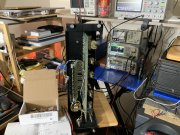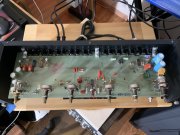mslupczynski
New Around These Parts
- Joined
- Jun 4, 2023
- Messages
- 15
I'm rebuilding a PL2000 and during checkout it operates reasonably well in it's current state. Injecting a 1khz signal shows good signal flow etc., and overall I believe the unit is a good candidate for restoration and perhaps some opamp replacing from BrownDog to bring it up a level. As well as other mods I've seen out here that I'm continuing to research.
One thing I'm really wondering about - after a decent cleaning of the control pots and switches - there is still a very loud POP/THUMP when activating the tone control switch. I suspect more cleaning will not fix this and I'm wondering if it's maybe a cap issue. If so, perhaps this be alleviated when the responsible cap(s) in the tone control circuit are replaced?
If not, I'm pretty sure others have seen this issue and I'd love to know what might be causing it and if it has a known fix.
Thanks
One thing I'm really wondering about - after a decent cleaning of the control pots and switches - there is still a very loud POP/THUMP when activating the tone control switch. I suspect more cleaning will not fix this and I'm wondering if it's maybe a cap issue. If so, perhaps this be alleviated when the responsible cap(s) in the tone control circuit are replaced?
If not, I'm pretty sure others have seen this issue and I'd love to know what might be causing it and if it has a known fix.
Thanks


